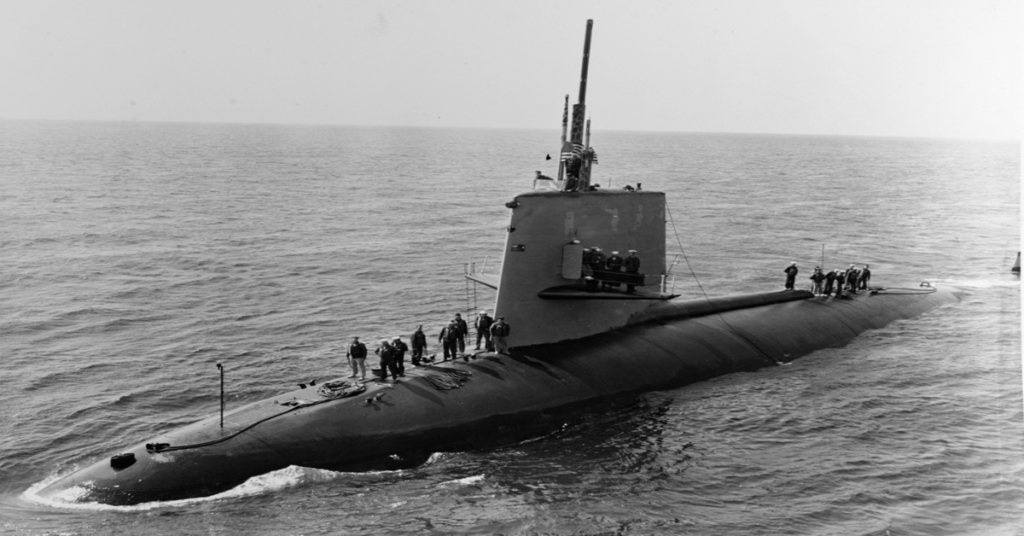
Dive into the enigmatic depths of the Cold War as I unravel the story of the USS Scorpion, a vessel whose disappearance still echoes in the annals of maritime lore. Lost to the Atlantic’s murky embrace with 99 souls aboard, the Scorpion’s fate is a chilling reminder of the era’s perilous brinkmanship.
Stay with me as we embark on a deep dive into the abyss, where history and mystery collide in the silent world of submarines.
USS Scorpion Research Questions – The Most Popular Theory
When I first learned about the USS Scorpion, the haunting story of its disappearance captivated me. Countless theories have surfaced regarding this mystery, but one has become particularly noteworthy.
The Explosive Malfunction Theory
It’s widely discussed that an internal torpedo explosion might have been responsible for the loss of the USS Scorpion. This theory hinges on several key points:
- Malfunction: It is frightening to think that a torpedo could have activated while still aboard. If a torpedo started running within the confines of the submarine, it could explain a sudden and catastrophic event.
- Evidence: Analysis of debris and acoustic signals seems to support a violent internal event. The wreckage pattern suggested a rapid, forceful collapse, hinting at an explosion rather than a slow crushing by external pressure.
Popular Acceptance
What makes the explosive malfunction theory the most accepted explanation? Its simplicity and likelihood. While other explanations may involve espionage, this theory remains grounded in the possible malfunction of onboard equipment.
Relevance to Research
My fascination with the USS Scorpion compels me to recognize the importance of this theory in ongoing research. It shapes how investigators approach submarine safety and informs the design of modern torpedoes to prevent similar tragedies.
In the spectrum of explanations, the explosive malfunction theory stands out as a grim but plausible interpretation of the Scorpion’s fate, prompting continuous research and discussion in naval circles.
History and Design

The USS Scorpion (SSN-589) captivates history buffs and naval enthusiasts with its remarkable design and notable service during the Cold War. Let me guide you through its inception, features, and the duties it performed.
Conception and Construction
My interest in maritime history leads me to the Scorpion’s roots, where on a significant day, 20 August 1958, its keel was laid by the Electric Boat Division of General Dynamics Corp in Groton, Conn. With the experience of building submarines since World War II, this division was pivotal in constructing the vessel that would become an integral part of the United States Navy’s silent service.
Set afloat on 19 December 1959 and officially commissioned on 29 July 1960, the USS Scorpion began its journey in the tense environment of the Cold War. The Naval History and Heritage website offers more about this Skipjack-class attack submarine.
Skipjack-Class Features
The USS Scorpion was molded into the Skipjack-class, a design representing a significant leap in submarine technology, primarily due to their nuclear propulsion systems. These submarines, including the Scorpion, were distinct for their teardrop-shaped hulls designed for underwater speed and agility.
Incorporating a nuclear power plant allowed these vessels to remain submerged for extended periods without surfacing, which was a critical advantage during underwater missions.
Service History
Stationed at Norfolk, the USS Scorpion’s service history reflects a timeline of challenges and milestones. Throughout its active years, the Scorpion proudly participated in numerous United States and NATO exercises across the Atlantic and Mediterranean. These operations were aimed at refining tactics in nuclear submarine warfare and often included deployments of a secretive nature.
The prestige of the Scorpion’s service, marked by silent diligence, resonates with the ethos of the naval fraternity. Tragically, it was lost with all hands on 22 May 1968, making it one of the two nuclear submarines the U.S. Navy has lost. The mystery that shrouds the disappearance of the Scorpion still lingers as a sad chapter in naval history.
Disappearance and Investigation

When discussing the fate of the USS Scorpion (SSN-589), the mystery surrounding its sinking captivates me. The submarine’s sudden disappearance in the Atlantic and the resulting investigation engender a multitude of theories and unyielding intrigue.
The Sinking Incident
On its way back to Norfolk Naval Shipyard from a Mediterranean deployment, the USS Scorpion failed to return as scheduled. On May 22, 1968, the Scorpion, with its crew of 99, was reported missing near the Azores in the Atlantic Ocean.
On its service with Submarine Squadron 6 and the Atlantic Fleet, the Skipjack-class nuclear attack submarine was anticipated to transit back to the U.S. following NATO exercises. This vanishing event raises numerous questions about submarine warfare tactics and the hazards faced by such vessels during the Cold War era.
Search and Discovery
The search for SSN-589 involved extensive efforts by the U.S. Navy, including deploying Mizar (T-AGOR-11), an oceanographic research ship. Eventually, the wreckage was located approximately 400 miles southwest of the Azores, roughly in the direction of the Canary Islands. The findings by Mizar, which also functioned as part of the Sixth Fleet, pointed to the wreckage sitting on the sea floor, deep in the Atlantic.
Aftermath and Theories
A Court of Inquiry was established to investigate the incident, yet the conclusions drawn did not provide a definitive cause for the sinking. This led to numerous theories, some contemplating a cover-up. Diverse explanations range from a battery explosion to a torpedo malfunction, each examined and debated within and outside the Navy.
Commendations, such as the Navy Commendation Medal, were posthumously awarded to the crew. However, the absence of conclusive evidence fuels speculation regarding the USS Scorpion’s disappearance and the U.S. Navy’s transparency about the circumstances.
FAQ – USS Scorpion

Uncover the enduring enigma of the USS Scorpion’s vanishing with my comprehensive FAQ section to answer your most pressing questions about this Cold War submarine mystery. Delve into the depths of naval history and theories that continue to surface decades later.
What sank the USS Scorpion?
After analyzing the ship’s battery cells, this is the leading theory for the Scorpion’s loss. This is consistent with two small explosions aboard the submarine, a half-second apart, that were picked up by hydrophones.
What is the Scorpion submarine?
USS Scorpion (SSN 589), a Skipjack-class nuclear-powered submarine, was commissioned on July 29, 1960. On May 27, 1968, the submarine was presumed lost after failing to arrive in port on Memorial Day from a three-month deployment to the Mediterranean Sea.
Did the USS Scorpion implode?
Nobody knows why the USS Scorpion sank. What is known is that she was destroyed due to her hull imploding at 18:42 on the 22nd May 1968.
Do you also have theories about the fate of the USS Scorpion? Share your insights and join the conversation below – we value your perspective on this maritime mystery!

